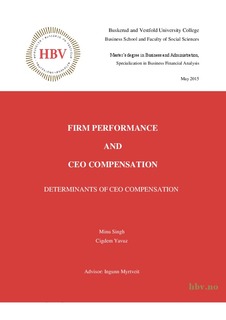| dc.description.abstract | CEO compensation is a much discussed concept in the media and in the society in general. The center of the discussion is mostly around the high CEO compensations and the gaps between the compensation to the CEOs and to rest of the employees. As this is an interesting and topical concept, we hence wanted to examine how CEO compensation is determined in firms listed on the Oslo Stock Exchange. We wanted to examine if CEOs actually get their compensation for obtained firm performance, or if there are other factors that determine their compensations. Hence, we constructed the following research question:
“Is there a positive relationship between firm performance and CEO compensation in firms listed on the Oslo Stock Exchange, or are there other determinants of CEO compensation?”
We have based our theoretical framework on the principal-agent theory, the managerial power theory, aspects around corporate governance, the empire building theory, and the human capital theory. We consider these theories as the most essential theories of the pay-for-performance relationship and for determinants of CEO compensation. Additionally, we have examined previous empirical researches based on the presented theories that find a weak or a non-existing pay-for-performance relationship, and that there are other determinants of CEO compensation that affect the pay-for-performance relationship. We have hence divided our study in two, where we first have examined the pay-for-performance relationship with control variables, and then examined these control variables’ direct effects on CEO compensation.
We have measured firm performance by four market-based measures, P/B, P/E, Jensen’s alpha and Tobin’s Q, and three accounting-based measures, ROE, ROA and EVA™. We have also divided CEO compensation in both fixed salary and variable CEO compensation. We have further included control variables as firm size, firm risk, ownership structure, CEO’s age, CEO’s tenure, CEO’s gender, CEO change, privately and publicly owned firms, board size and number of female directors to see their effects on the pay-for-performance relationship, and to see if they are determinants of CEO compensation. We have however not tested CEO change’s direct effect on CEO compensation, and we have further not been able to test the effects of CEO’s gender and privately and publicly owned firms because of few observations.
Our results show that there is a weak, but positive relationship between firm performance and CEO compensation, measured by change in ROE. Additionally, we find a negative and Firm performance and CEO compensation significant relationship between change in P/B and variable CEO compensation that is difficult to explain by economical rationality, as the principal-agent theory assumes that there is a positive relationship between firm performance and variable CEO compensation. Further, our results show that there is no positive relationship between firm performance and fixed salary as predicted, but we surprisingly get a negative and significant relationship between change in P/B and change in fixed salary that also cannot be explained by economical rationality.
Similar to other studies, our results show that there are other variables that affect the pay-for-performance relationship. We find that the pay-for-performance relationship is stronger in smaller firms than in larger firms, which is consistent with the managerial power theory and the aspects around corporate governance that discuss that large firms have multiple owners who can easily be influenced by the CEO. Additionally, the pay-for-performance relationship is stronger in low-risk firms than in high-risk firms, which is consistent with the principal-agent theory that assumes that owners give higher incentives to the CEOs in order to release them from risk. Further, consistent with the human capital theory, we find that age weakens the pay-for-performance relationship as older CEOs are more experienced and have more responsibilities which eventually will increase their compensation independent of firm performance. CEO change also weakens the pay-for-performance relationship, indicating that a new CEO is not punished or rewarded for performance obtained by a previous CEO. Lastly, the size of the board of directors and the number of female directors weaken the pay-for-performance relationship as the board faces coordination problems, and are not able to function like a unit.
Further, we find that there are other variables that have a greater effect on CEO compensation than firm performance. Our results show that CEO compensation is determined by firm size, firm risk, and the number of female directors. Surprisingly, we find that CEO’s direct ownership is negatively significant with fixed salary, which may indicate that CEOs are willing to receive lower fixed salaries when they own firm shares. Hence, our study gives insight in both the pay-for-performance relationship, factors that affect this relationship, and determinants of CEO compensation in firms listed on the Oslo Stock Exchange. | nb_NO |
